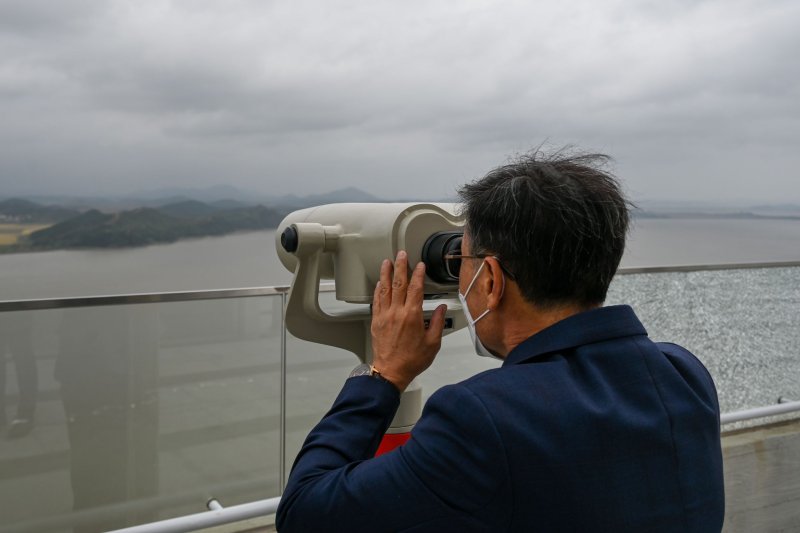1 of 6 | Gimpo Mayor Jeong Ha-young looks through binoculars across the Han River estuary into North Korea, less than a mile away, from the new Aegibong Peace Ecopark observation deck in Gimpo, South Korea, on Wednesday. Photo by Thomas Maresca/UPI |
License Photo
SEOUL, Oct. 5 (UPI) -- As tensions appear to be lifting on the Korean Peninsula, local officials in South Korea unveiled a new park on the border with the North that they hope will draw tourists and help build a new spirit of cooperation.
Aegibong Peace Ecopark, an exhibition hall and observatory in Gimpo, a satellite city west of Seoul, hosted a conference for foreign media and ambassadors Tuesday. The site will officially open to the public Thursday.
"This park will become a landmark of peace," Gimpo Mayor Jeong Ha-Young told reporters.
Its observatory is situated on Aegibong Peak, 500 feet above an estuary of the Han River, and offers some of the closest views of North Korea available to civilians.
At less than a mile across the river, a small village of squat concrete buildings, farmland and guard posts can be seen easily with a zoom lens or the observatory's installed binoculars.
Meanwhile, a four-story exhibition hall offers high-tech displays on the history and the ecology of the area, a once-thriving port where the Han and Imjin Rivers meet and flow into the Yellow Sea.
The local government spent about $33 million on the project, replacing an observatory originally built in 1978 but left abandoned for several years, Jeong said. The park's grounds are home to a regiment of South Korean marines and previously had only restricted access.
Officials in the administration of President Moon Jae-in have long been hoping to turn areas along the DMZ into sites for "peace tourism," and began operating tours and pilot programs in 2019, during a period of inter-Korean rapprochement that was highlighted by a trio of summits.
Relations froze during June last year, however, when North Korea cut off all communication and destroyed a joint liaison office in its border town of Kaesong.
In recent weeks, Pyongyang once again has softened its tone toward Seoul, and on Monday it reopened the severed communications and military hotlines.
Along with attracting tourists, Jeong said he hopes the park can help restart engagement with the North on humanitarian and conservation projects.
He is looking to have the area on both sides of the border declared a joint Ramsar site, a UNESCO designation for wetlands of international importance.
"Maybe inter-Korean relations will be developed in a new way," Jeong said. "Local governments of North and South Korea will cooperate on shared issues."
Germany's ambassador to South Korea, Michael Rieffenstuel, said at the conference Tuesday that smaller-scale connections among local communities in East and West Germany played an important role in laying the groundwork for reunification in 1990.
"I think that people-to-people contacts actually were at least as important, if not more important, than the government-to-government policy," Rieffenstuel said.
"Sooner or later, the two Koreas will take the same path as Germany," Jeong said. "As peace comes to Gimpo, it will come to all of Korea."
A tourist hangs a message of peace on a "hope tree" along the DMZ Peace Trail. Visitors can hang plastic "leaves" with messages on the tree. One message, addressed to a father and grandfather, read: "Now that I'm at the DMZ, I'm hoping for reunification. Rest in peace." Photo by Thomas Maresca/UPI |
License Photo
















